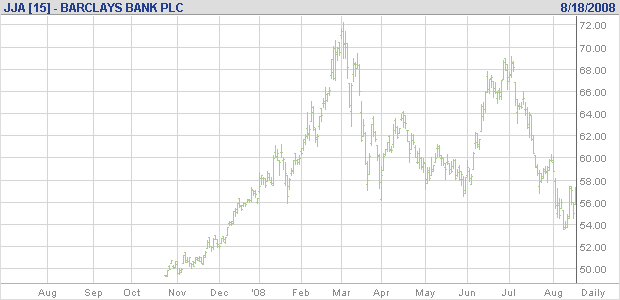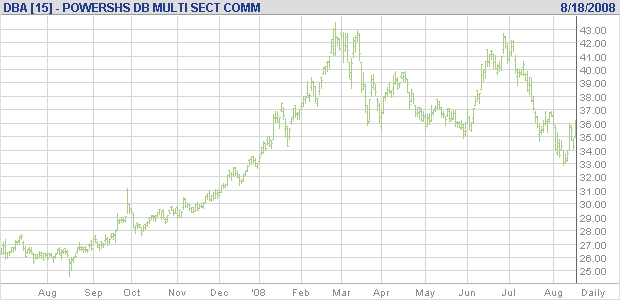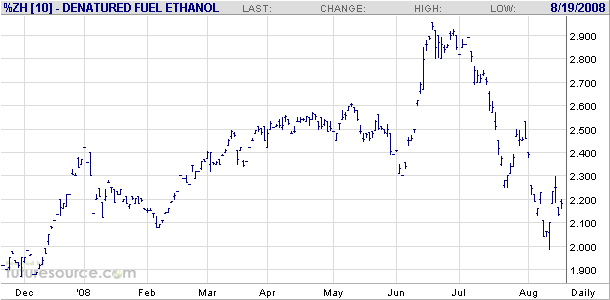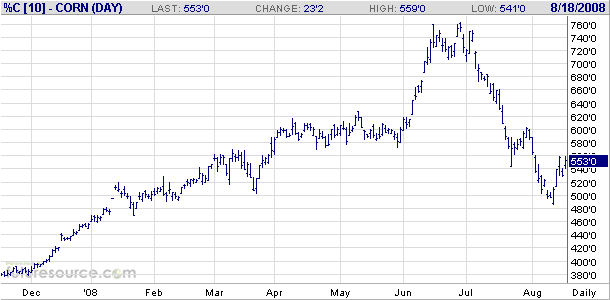(9 am. – promoted by ek hornbeck)

Greetings ladies and gentlemen to the latest episode of Manufacturing Monday. Couple of interesting things to discus today, and some interesting numbers to watch this week. First we have what appears to be a new take on price fixing by manufacturers. Next we explore the recent collapse in the price of grains. Our last piece is a story from the Financial Times where companies and groups are hiring the very element that help drive up their costs, speculators, to well…sorta fight speculators. Kinda reminds me of those old westerns where they hire a gunfighter to take on the baddie. Finally, as mentioned, there are numbers we’re watching, the Producer Price Index being released tomorrow, Jobless claims and the Philadelphia Fed Survey on Thursday.
Woe be the retailer who wants to mark down a product!
Wall Street Journal’s front page today had somewhat of an eye-opener of a story involving the pricing of goods and retailers. Essentially, what we have here is a new back-handed way on price fixing. Because the laws on the books prevent companies from getting together and settling on a price, something going as far back as 1911, companies have been trying to find a way around it.
Manufacturers are embracing broad new legal powers that amount to a type of price-fixing — enabling them to set minimum prices on their products and force retailers to refrain from discounting.
For the better part of a century, punishing retailers for selling at cut-rate prices was an automatic violation of antitrust law. However, a Supreme Court ruling last year involving handbag sales at a Dallas mom-and-pop store, Kay’s Kloset, upended that original 1911 precedent, potentially altering the face of U.S. discount retailing.
Retailers say an array of manufacturers now require them to abide by minimum-pricing pacts, or risk having their supplies cut off. Jacob Weiss of BabyAge.com, which specializes in maternity and children’s gear, says nearly 100 of his 465 suppliers now dictate minimum prices, and nearly a dozen have cut off shipments to him. “If this continues, it’s going to put us out of the baby business,” he says.
– excerpt from “Price-Fixing Makes Comeback After Supreme Court Ruling“, Wall Street Journal, 2008
Manufacturers last year won in a Supreme Court ruling that legitimizes in their eyes what many see as a new way to set prices. While it is still illegal for, say for example, a group of hammer manufacturers to colluding on a single price, each company does under the ruling have the right to set a “minimum price.” I’m sure you’ve seen these at stores as well, commonly known as “Manufacturer Suggested Retail Price” or MSRP, be it in automobiles to vacuums. But then you get a situation where a small mom & pop retailer (online or bricks & morter) want to sell something below the MSRP. That’s when the trouble starts, because many are finding that they are facing retaliation by their suppliers, often in the cancellation of product shipments.
Now perhaps Walmart has the muscle to sell stuff even at below prices manufacturers are willing to tolerate, but for the rest of the retail world, it’s screw you time. Of course, the ruling actually does open the door in collusion, because you could have a commodity-like product, say adhesive tape, and there is nothing to stop one company from having a similar MSRP to another. Information on competitor’s products are readily available. And this writer isn’t the only one who thinks so, as the article noted, so have several attorney generals that have been prodding the Democratically-controlled Congress to pass some legislation.
Inflation is another specter in this, as consumers we don’t really what it costs to make a widget, and most likely that product was made in a low-wage nation. There is nothing to stop them from saying to a retailer that they are raising their MSRP. I grant you, manufacturing, unless it’s one of those untouchable niche products, is a dog-eat-dog world. American-based manufacturing has been taking a hit for decades, and perhaps they need some sort of protection, of which I am not sure in what form outside of tariffs (itself an inflationary product). But lets be honest here, 90% of the stuff is made in China or some where else in the wage arbitrage game and that brings in a fat profit margin for manufacturers. If one retailer lowers the price below the manufacturer’s suggested retail price, that could see a cascading effect and eventually hit this off shoring companies.
I needn’t bring up the fact that retail is in a very precarious situation. Retail small business owners are having a hell of a time competing against big-box retailers who can get a different MSRP. These folks need every help they can get. The other day, I walked into Golf Mill, one of our local malls, and the smaller stores that used to be there are disappearing. Also, as a consumer, shouldn’t we be upset at this, given that in such a shitty economy that it’s our duty to look for a bargain? We’re supposed to live in a “free market” economy, well when it comes to these wage arbitragers, that only applies to their profits from shifting costs overseas.
Did seasonality just strike grain prices?
During the past Summer, we’ve been discussing the rising cost of food. This had been linked to rising prices in grains and transportation costs, mainly the former. Demand for alternative utilization for products like ethanol was one the major boosters in price; and when sees a fundamental shift in such a product would only invite further speculation. You will see in the charts below, that the grain complex made new highs over the Summer.

(Barclays Bank Agricultural Exchange Traded Fund, JJA)

(Deutsche Bank Liquid Commodity Index – Optimum Yield Agriculture Excess Return, DBA)

(Ethanol futures continuous contract chart)
Now the purists will be angry at me for not simply posting up something like the Goldman Sachs Commodity Index or the Dow Jones-AIG Commodity Index or that one by Jim Rogers (that includes even Azuki beans!) to show the big drop I’m talking about. But I figure, you know what, perhaps the folks at home want to follow this, so what better way than to bring up ETFs that actually correlate with the moves in the grain complex? Just in case you don’t know what an Exchange Traded Fund (ETF) is, its sorta like a mutual fund but it trades like a stock in that you can get in an out more easily (some are more liquid than the stuff they track!), and there are hell of a lot less fees involved.
Anyways, the first one is the Barclays Bank Dow Jones-AIG Agricultural ETF, which follows that one major index I mentioned earlier, only this one is mainly stuff like the grains and cotton and sugar. The next one, the Deutsche Bank Liquid Commodity Index is a bit more “pure” in that it only covers corn, sugar, soybeans and wheat; stuff that has been proposed or is used to go into ethanol. The second one is actually based on a fund being traded, which is kinda cool if you think about it. Last, but not least, is the actual ethanol futures chart itself!
You may immediately notice that the three really correlate. First let me apologize on the way the Ethanol chart looks, bad formatting of the chart from the the site. But if you look, the peaks almost match up. DBA made an all time high in early part of the year, which oddly enough didn’t take shape in the ethanol future. Yet the two did reach peaks about the same time in early Summer then dropping. The same could be said for the Barclays index as well. Ethanol dropped from a high of $2.90 to as low as 2 bucks before settling around $2.20, making it a fall of about 24% from it’s high. Barclays’ Dow Jones-AIG ETF has fallen 19%, while DBA has dropped 16% from it’s last peak. So what’s this all mean?
Perhaps we will start to see a drop in overall food prices around the world. What happened was a normal cycle, known as seasonality, that was accentuated by an influx of speculation. Ok, let me clear that up. You will always see an increase in speculation when the seasonal bull cycle starts. Hedgers (those who use or grow the stuff) may start to take some money into additional speculative trades. Also, those who understand seasonality, and only the bullish side, may hope in again for the year. But what made this different was that one saw the emergence of new players who normally didn’t play these markets, and it happen to occur just as the seasonal peaks were starting. You had energy traders and energy companies entering the agricultural pits (think ethanol craze), and the creation of commodity ETFs, and with the drop in the stock market, investors like pensions going into the commodities markets because they hear people like Jim Rogers say that’s where you should be. I think it’s important to understand the difference here between those who normally play these markets and the addition of new players. Indeed, what I think we saw here was a replay of the craze you saw in pork bellies about two decades ago.
Have funny colored trading jacket – will travel
The influx of cash has brought about an increase in volitility in the agricultural markets. From the grain complex to lumber to oil, the price swings between highs and lows has grown. Hedgers, that is everyone from farmers to companies that buy their goods, were caught off guard.
For many years, companies who dealt in such items knew better than not to find a way to offset a potential rise in costs. That’s how Southwest Airlines has managed to stay afloat while the other airlines faced catastrophe, because they managed to purchase oil contracts going out decade or so. Farmers have known this for ages, indeed the first futures trading, at least that I’m aware of, was done between rice merchants and farmers in 1500s Japan! Yet despite knowing all this, recently companies, as the FT article notes, neglected such operations. A negligence, that many manufacturers and food retailers discovered at their own peril.
Food companies were once a little blasé about the price they paid for the ingredients that went into their corn flakes, chocolate bars and yoghurts because in the 1980s and 1990s, prices of agricultural commodities were falling.
While many food companies took the precaution of hedging some of their key ingredients – Mars, the owner of Snickers bars, has been hedging cocoa since the 1960s – they did not have to worry too much about being caught out by unexpectedly big price jumps.
Today, that luxury has vanished. Soaring global demand for commodities has driven prices of all kinds of food ingredients, from corn to cocoa to coffee, to new highs, and more than a few food companies have been unpleasantly surprised.
– excerpt from “Hedging is second nature for food groups“, Financial Times, 2008
It’s this volatility, that has given both farmers and agricorps pause. One need only look at the chart of corn below to see what I’m saying. For farmers, this year has been both a boon and a disaster. Rising demand from ethanol and the destruction of crops from floods caused the price of the “other yellow gold” to jump to new highs. Yet, an influx of new money means an increase of volatility also means a downfall.

Its these lessons that has gotten companies to wake up. Now instead of weathering a future commodities (no pun intended) storm, they can attempt to reach something of stability with these costs. This is where, as another Financial Times article points out, the speculator comes in. You see, for as much demonization that the speculator get (and lets be honest, they aren’t exactly innocent either!) they are a necessary evil. How so, you ask? Hedgers need someone to offset against. An airline may not find another producer of crude to sell them oil at a given price, hence the speculator steps in to assume the risk. The speculator is hoping that the price will drop (he shorted the oil contract to the airline) and make a profit. Of course if it goes up, and if he’s a seasoned player he or she will have also offseted their trade with another. But if not, well then they take a loss. But you see this is where the real professional speculators come in, and no I’m not talking folks like the failed hedge fund Amarath or LTCM. Companies like Carghill or Man Financial, who have a long history in these markets. They know how to hedge properly, it’s not win-win, but they know how to unload risk.
Food and consumer goods companies are overhauling the way they buy and hedge commodities after being caught out by increases in the prices of raw materials that have squeezed industry margins and cut profits.
Companies are turning to commodity trading houses for the first time to hire traders and are buying complex financial trading systems to help them cope with a new era of global inflation.
Such decisions suggest executives have realised that volatile commodity markets are not a short-term phenomenon but a structural change driven by rising demand from emerging markets.
Peter Evans, co-ordinator of the European consumer products practice at headhunter Russell Reynolds Associates, said companies were approaching trading houses such as Cargill, Bunge and ADM to find traders who understood volatile markets.
“If they can buy commodities more intelligently than their competitors, that can be a competitive advantage,” he said, adding that the firm had been hired to fill a new role of global commodities procurement director at one of the biggest food groups.
– excerpt from “Food and consumer groups get hedge smart“, Financial Times, 2008
Now one question I’ve always been asked is, what about the poor? Dirt-poor farmers in South America, or those who suffer from malnutrition cannot afford the services of Archer Daniels Midland Company. And that is true they cannot. Food relief programs that are forced to buy grain on the open market are at risk with this new era of food volatility.
I’ve always hoped, well perhaps hope is not the appropriate word, ok lets just say I’ve wanted that these companies would donate their resources to helping out organizations like these. Who knows, maybe some do, but I highly doubt it. You won’t really ever eliminate speculation in grains, but one could attempt to establish a program that helps alleviate some of the damage caused by speculation in at least the grain market. Lawyers have done pro-bono work, why can’t for a tax goodie, commodity pools marshal some of their money for grain shipments to places like Darfur or India? Something to think about.
Cross posted on
The Economic Populist –
A Community Site for Economics Freaks and Geeks

5 comments
Skip to comment form
Author
The weekend is over, I know, I’m still sobering up as well. Anyways, that still gives us a whole week to think about what to do next weekend or wonder if you made a mistake sleeping with that waitress at the Denny’s.
are dropping because of the news that the chimp was sending people to negotiate with Iran? Someone pointed this out–I think at Big Orange–but it was right after he stopped beating the drum for war with Iran that oil prices began to fall…which makes me think global nervousness about yet another Bu$hco disaster was driving oil prices, not speculation.
I thought the corn prices went down because after the water cleared the damage done by the floods wasn’t as bad as had been predicted plus the farmers had planted more fields with corn then they had previously, thus amplifying the amount of projected loss for 2008, but not so bad when compared to prior years due to increased planting.